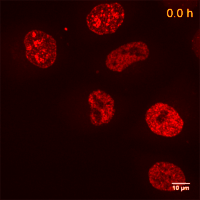Novel cell cycle modulators identified using the Cell Cycle Chromobody Technology
Cell Cycle Chromobody for live cell imaging
Cell cycle and cell proliferation are tightly controlled cellular processes, and their deregulation is a hallmark of cancer. To enable non-invasive analysis of cell cycle in living cells, ChromoTek developed a Cell Cycle Chromobody. The Cell Cycle Chromobody (CCC) consists of a binding domain of a heavy-chain antibody highly specific against human proliferating cell nuclear antigen (PCNA), which is genetically fused to a fluorescent protein.

When transfected into human cells, CCC facilitates real-time monitoring of cell cycle without affecting intracellular amounts of PCNA or other proteins involved in cell proliferation. For screening of chemical compounds interfering with the cell cycle, ChromoTek generated stable HeLa and U2OS cell lines with a homogenous expression of CCC, precisely tailored for high-content analysis (please contact support.de@ptglab.com for more details).
In the recent issue of the Journal of Biomolecular Screening, K. Schorpp and his colleagues from the Helmholtz Centre in Munich, Germany, describe the application of CCC for identification of novel cell cycle modulators (Schropp et al., 2016). In a multiplex approach combining the CCC technology with the CytoTox-Glo read-out, they screened 960 Food and Drug Administration (FDA)-approved drugs. In this screen, CCC enabled them to visualize cell-cycle dependent dynamic distribution of endogenous PCNA and discriminate cell cycle phases in a high-throughput format. The authors emphasised in the manuscript, that "in contrast to classical immunostaining protocols, the Chromobody technology offers the big advantage that no additional staining steps are needed to visualize endogenous PCNA. Moreover, this technology could be expanded to high-throughput live-cell imaging campaigns for the future that would create an additional layer of information about cell cycle dynamics.” The authors noted that CCC approach yields very high reproducibility and good Z′ values, and allows versatile multiplexing.
Out of 960 tested substances, K. Schorpp and colleagues could identify three compounds, which modulate different cell cycle stages: mebendazole, niclosamide and cladribine. Importantly, these compounds induced cell cycle arrest without showing early secondary cytotoxicity. The authors determined that mebendazole (10μM) led to an arrest of cells in the M-phase, whereas the compound niclosamide (1μM) increased the cell population of the G-phase, and the compound cladribine (10μM) arrested the cells in the S-phase. The authors suggest that in the future, these small molecules could contribute to the development of novel drug candidates for cancer treatment, or serve as tool compounds for their use in basic research.
Reference:
Related Content
Nanobody-based reagents by ChromoTek
Intracellular Nanobodies for live-cell analysis in real-time
Chromobodies for live cell imaging
Actin Chromobody for live-cell super-resolution imaging
Visualize Histones in live cells: Histone-Chromobody
Visualize the onset of metastasis with Chromobodies
Actin Chromobody: Visualization of actin dynamics – NOT alteration

Support
Newsletter Signup
Stay up-to-date with our latest news and events. New to Proteintech? Get 10% off your first order when you sign up.
